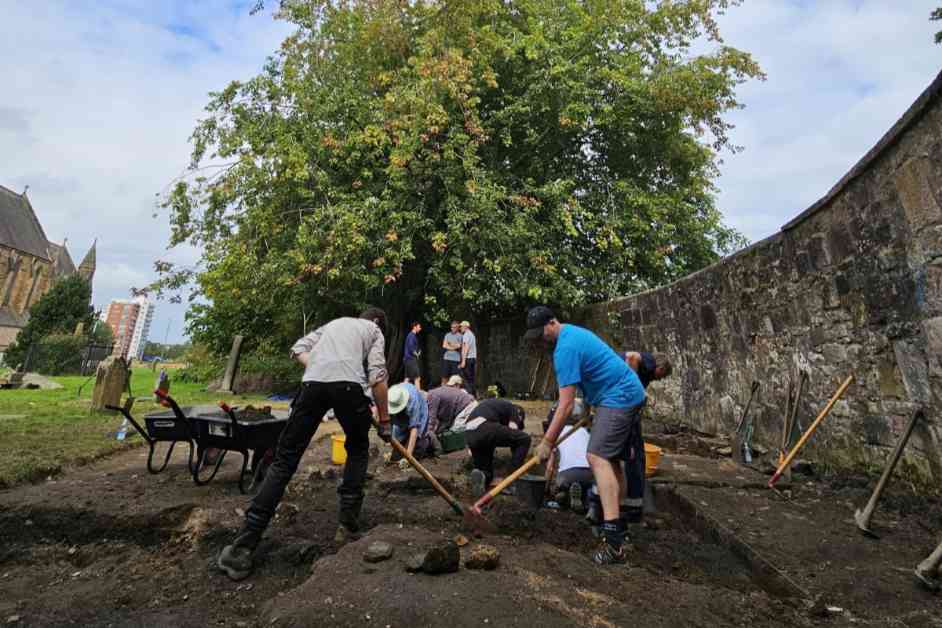Uncovering Glasgow’s Rich Viking History Through Archaeological Digs
Glasgow, a city renowned for its rich history and cultural heritage, is once again opening its doors to residents and history enthusiasts alike to take part in an exciting archaeological dig that aims to uncover Scotland’s deep connections with Vikings. This unique opportunity, organized by the University of Glasgow in collaboration with the Society of Antiquaries of Scotland and The Govan Heritage Trust, invites locals in Govan to join experts in surveying and excavating the Govan Old churchyard.
Located in Govan, the churchyard holds significant historical importance as it is believed to be the site where the entrance of the medieval church once stood. It was also the location where a new fragment of an early medieval sculpture was unearthed in 2023. Additionally, the corner being investigated this year is where the 1,000-year-old Govan sarcophagus was discovered during grave-digging in 1855. The exterior of the sarcophagus is said to depict Constantine, King of the Picts, who was reportedly killed by Vikings in the 870s.
The upcoming archaeological digs mark a continuation of last year’s successful community project that led to the discovery of the ‘Govan Warrior’ stone. Experts are eager to unearth more artifacts this year that will shed light on Scotland’s Viking past and help piece together the historical puzzle of Govan’s ancient roots.
Exciting Community Involvement in the Archaeological Excavation
Stephen Driscoll, Professor of Historical Archaeology at the University of Glasgow and Trustee of Govan Heritage Trust, expressed his enthusiasm for this year’s archaeological endeavor. He highlighted the team’s plans to delve into Govan Old’s deep history by meticulously mapping the graveyard and excavating at the find spot of the ‘Warrior Stone,’ where the sarcophagus was originally discovered in the 19th century.
The community plays a vital role in this year’s digs, with opportunities for volunteers to work alongside professionals from Clyde Archaeology and University of Glasgow Archaeology. The first community dig is scheduled from August 29 to 31, followed by a second session from September 20 to 22. With over 500 attendees at last year’s community dig, organizers are hopeful that the discovery of the ‘Govan Warrior’ will inspire more people to participate and engage with Glasgow’s fascinating Viking history.
Dr. Simon Gilmour, Director of the Society of Antiquaries of Scotland, emphasized the importance of community involvement in preserving and exploring local heritage. The society’s grant will facilitate active participation in archaeological fieldwork throughout 2024, fostering a deeper connection between the community and Scotland’s rich archaeological heritage.
Unveiling Glasgow’s Hidden Treasures: The Govan Warrior and Beyond
The unearthing of the ‘Govan Warrior’ stone during last year’s excavation unveiled a remarkable piece of Glasgow’s history. This early medieval carved stone, depicting a man carrying a shield and a shaft, captivated experts with its unique design and intricate details. Despite the warrior’s face being damaged over time, distinct features such as a flowing ponytail and sharply pointed beard offered a glimpse into the craftsmanship of over a thousand years ago.
The Govan Warrior’s discovery sparked renewed interest in Govan’s local heritage, prompting a closer examination of the site’s historical significance. As researchers continue to uncover hidden treasures, such as the sarcophagus and early medieval sculptures, the community’s involvement becomes increasingly crucial in preserving and understanding Glasgow’s vibrant past.
The Govan Old church, dating back to the sixth century, stands as the oldest known Christian site in Glasgow. With its rich historical background and architectural significance, Govan Old serves as a testament to the city’s enduring heritage and the importance of preserving its cultural legacy for future generations to appreciate.
Supporting Research and Preservation of Scotland’s Archaeological Heritage
The Society of Antiquaries of Scotland plays a pivotal role in supporting high-quality research and publications related to Scotland’s past. Through grants and awards, the society funds various projects that delve into different aspects of Scottish history and archaeology, contributing to a deeper understanding of the country’s rich cultural heritage.
In a recent round of funding, the Society of Antiquaries of Scotland awarded grants to ten projects focusing on diverse topics such as boat burials, Neolithic sites, and antiquarian travels. These initiatives aim to shed light on Scotland’s past and preserve its archaeological treasures for future generations to explore and appreciate.
As the society continues to support research endeavors across different fields, the collaborative efforts of researchers, archaeologists, and local communities play a crucial role in uncovering hidden histories and preserving Scotland’s cultural legacy for generations to come.
The ‘Dig Where You Stand’ initiative invites volunteers to participate in this year’s archaeological digs at Govan Old, offering a unique opportunity to engage with Glasgow’s Viking past firsthand. By joining the excavation efforts, volunteers can contribute to unraveling the mysteries of Govan’s ancient history and play a part in preserving Scotland’s rich archaeological heritage for future generations to discover and cherish.















